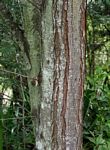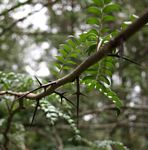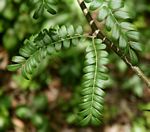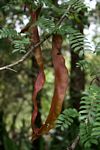Gleditsia triacanthos
Selected images: Click on each image to see a larger version and details of the record View all images (6)
Detailed records: Display species records QDS maps by: Google Maps Point records by Google Maps
Species details: Click on each item to see an explanation of that item (Note: opens a new window)
| Synonyms: | |
| Common names: | Honey locust (English) |
| Frequency: | |
| Status: | Introduced |
| Description: |
Shrub or small tree, armed with stout 3-forked spines, grown as a garden ornamental and known as a very occasional naturalized escape. Bark fairly smooth but splitting into vertical fissures on older stems. Leaves variably pinnate or 2-pinnate, even on the same branch, with a single pair of pinnae; leaflets 8-13 pairs per pinna, opposite, oblong-elliptic, up to 3.5 cm long, glossy green; margin finely scalloped. Flowers in axillary heads, unisexual on different trees, small, green. Fruit a flat woody pod, 15-30 cm long, often twisted when older, indehiscent. |
| Type location: |
|
| Notes: | |
| Derivation of specific name: | triacanthos: 3-spined |
| Habitat: | |
| Altitude range: (metres) | |
| Flowering time: | |
| Worldwide distribution: | North America. |
| FZ divisions: | C |
| Growth form(s): | Tree. |
| Endemic status: | |
| Red data list status: | |
| Insects associated with this species: | |
| Spot characters: | Display spot characters for this species |
| Images last updated: | Sunday 1 February 2009 |
| Literature: |
Other sources of information about Gleditsia triacanthos:
Our websites:
Flora of Mozambique: cultivated Gleditsia triacanthosFlora of Zimbabwe: cultivated Gleditsia triacanthos
External websites:
African Plants: A Photo Guide (Senckenberg): Gleditsia triacanthosAfrican Plant Database: Gleditsia triacanthos
BHL (Biodiversity Heritage Library): Gleditsia triacanthos
EOL (Encyclopedia of Life): Gleditsia triacanthos
GBIF (Global Biodiversity Information Facility): Gleditsia triacanthos
Google: Web - Images - Scholar
iNaturalist: Gleditsia triacanthos
IPNI (International Plant Names Index): Gleditsia triacanthos
JSTOR Plant Science: Gleditsia triacanthos
Mansfeld World Database of Agricultural and Horticultural Crops: Gleditsia triacanthos
Plants of the World Online: Gleditsia triacanthos
Tropicos: Gleditsia triacanthos
Wikipedia: Gleditsia triacanthos





